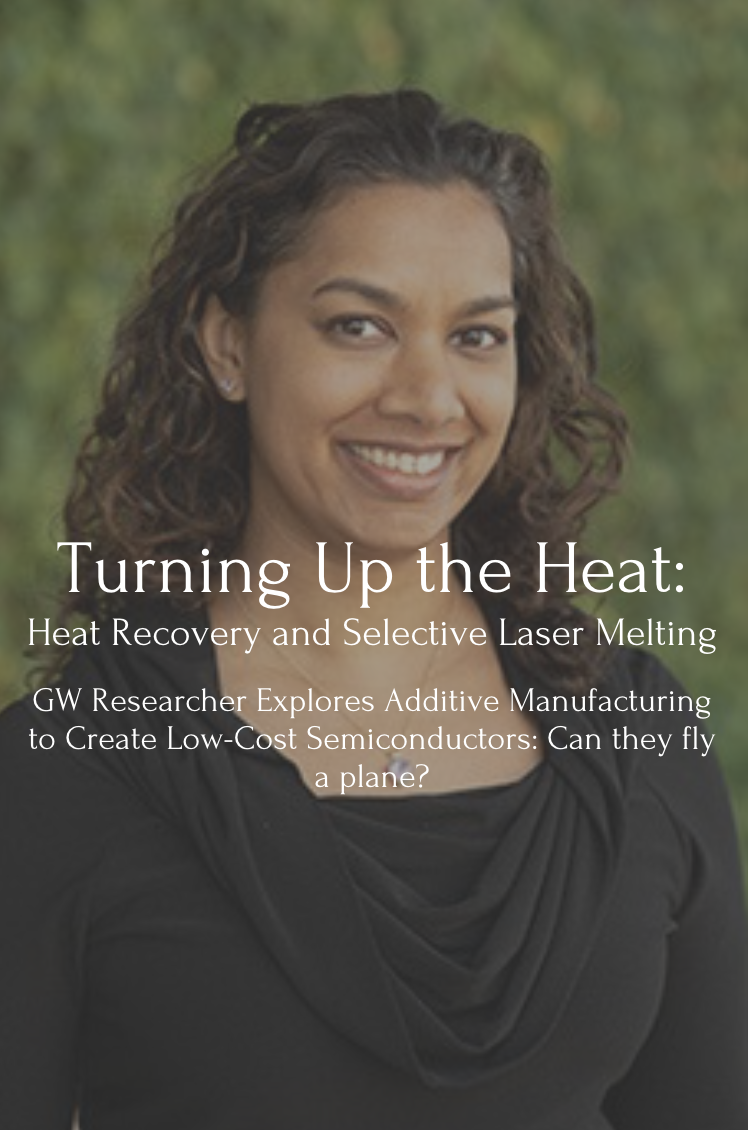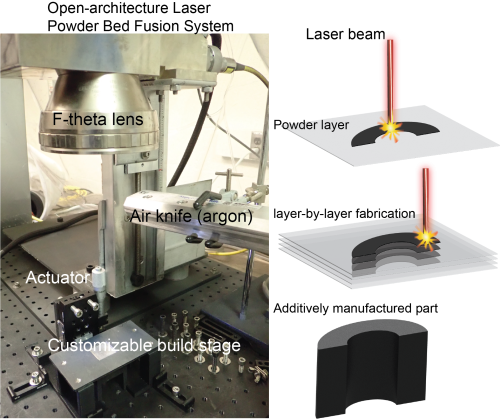GW Engineering Professor Saniya LeBlanc researches the intersection of materials science, energy conversion, and thermal transport. LeBlanc and her lab are seeking to make breakthroughs in ways to reduce energy waste, increase efficiency, and transform heat energy into a more useful form of energy – electricity – through the study of thermoelectric technologies. Her lab has been working to create inexpensive manufacturing techniques to make functional semiconductors using additive manufacturing and to integrate these semiconductors into other materials.
To make energy useful, humans typically convert one type of energy into another, for example converting sunlight to electricity via a solar panel, or releasing the energy stored in an atom of uranium through nuclear fission. But the process of converting, transferring, and using energy to perform useful work, such as running a laptop, also typically results in wasted energy, often in the form of unneeded heat. This approach of better utilizing energy through use of thermoelectric technologies is more promising than developing new technologies, she explained. By understanding how we use energy and the many sources of untapped energy available, researchers like LeBlanc could put us on a more sustainable energy path.
An edited transcript of the Alliance’s Interview With LeBlanc follows:
SPOTLIGHT: Could you provide us with a brief background on your work with 3D printing, heat recovery, and scalable electronic systems?
LeBlanc began by explaining the basics of heat recovery, thermoelectric technology, and how she entered this field.
LeBlanc: I have spent many years working with systems that convert one type of energy to another, and working to create a technology that can turn heat into electricity. I find this subject interesting because most energy comes in the form of heat, but humans primarily use electricity to power our devices. This causes the majority of wasted energy to be in the form of heat. If we could find a way to convert heat to electricity the amount of energy that is wasted would decrease.
“Heat recovery” is when we take the heat that is wasted and turn it into something useful like electricity. Heat recovery is done using thermoelectric technology, as this technology turns heat into electricity. A solar panel takes light from the sun and turns that light into electricity. But what if you could take something like heat from the human body and convert that heat into electricity to power your phone? That's what a thermoelectric device could do - convert heat to electricity.
Before becoming a professor at GW, I worked for a startup company whose goal was commercializing thermoelectric technology. Primarily we focused on harvesting wasted heat and converting it into electricity. Through my work there, I learned the process to create this technology was very challenging. In order to make this technology usable on a mass scale we needed to consider how we get it out into the world, and where we have heat that can be converted to electricity.
Leblanc then began to speak about her research lab at GW
When I transitioned to my research lab at GW, I decided to tackle the challenge of making this technology usable and asked: Is there a different way we could think about manufacturing these systems so they are more likely to get into the world where we can use them to convert heat into electricity, and then not waste so much heat energy? How would you do that? What kind of devices would you need? And then, how would you make it?
We did a lot of work in the first year of this research program where we were asking these questions, and where we ended up was additive manufacturing. Additive manufacturing is the technical term for the technique of 3D printing. We realized that the technique was actually going to be really useful in our work, but no one had ever done it for this kind of technology.
Leblanc started speaking about the 3D printing process, which led to a discussion on selective laser melting.
In 3D printing, you have a desktop printer that prints plastic parts. The materials we are working with are semiconductors, making the printing more complicated. Semiconductors are the materials that go into computers, phones, and tablets to make computer chips. Trying to find a way to 3D print semiconductors is a whole new science and engineering endeavor. We have been working on finding ways to 3D print materials that are different from plastics, leading us to break down the barriers for this kind of technology, make it into applications, and eventually commercialize it.
Engineers reserve 3D printing as the name for printing products using plastics; however, plastics can only get us so far. When you work with higher-end materials, such as metals, it is hard to create something that is a functional device if we are using the same techniques as with plastic. One of the techniques that we use to create metal structures is called selective laser melting, sometimes called laser-based powder. The way this process works is instead of a 3D printer squeezing hot plastic into a shape, we lay down a layer of metal powder, then take a laser and move it in the shape that we want the part to be. Wherever the laser hits the powder, you have a solid part in the shape. In the same way that 3D printing allows us to make shapes, so too can laser melting; you just have to melt the powder layer by layer. Once we proved this technique worked with metals and other materials, such as ceramics, we wanted to test whether it would work on semiconductor materials. This is part of the engineering research process, figuring out how to make a process work, what types of materials we can use selective laser melting on, and how we put these materials into creating laser-based 3D printers.
SPOTLIGHT: What new opportunities do you think the world is going to see based on being able to print semiconductor material?
LeBlanc: The reason that I moved into additive manufacturing is that I think we should be able to make tiles or bricks that have this material embedded within them. For example, what I envision is that the body of an airplane, which is currently just structural material, could instead have the exterior panels made of semiconductor material. Planes could be manufactured so their outer shells can convert heat into electricity to power the plane. That is what we are working on now; we can use this additive manufacturing technique to actually build structures where you could make a plane, a furnace, or whatever you want out of it. Instead of just being a structural material that will make sure the plane doesn't fall apart, it can also produce electricity at the same time.
SPOTLIGHT: Why did you choose to go into this line of research, and what makes this project valuable at this point in time?
LeBlanc: In the United States, about two-thirds of the energy we use is completely wasted, and the US is not unique in this. Most wasted energy is in the form of heat that is not used towards any purpose. This waste happens because we are inefficient in our energy usage. If we want to be more sustainable in our energy usage, we need to find new ways to generate electricity efficiently and use all the energy we create so it is not wasted. This work is important now, because it is crucial for us to stop wasting energy. It takes a lot of work to generate energy, so we should use that energy efficiently. All of the energy we generate has both environmental and human impacts associated with it, so it is imperative that the technology we are working on gets completed in order to transition to a sustainable energy future. This is just one small step, but when we research we cannot tackle everything. Research is something where we have to go deep and work hard on a specific idea. This particular technology I have a lot of expertise in, so I developed an idea as an engineer and invented something. The idea showed that there could be a lot of possibilities if we could make it work, so we investigate and do research to figure out what works and what does not work to achieve our goals.




